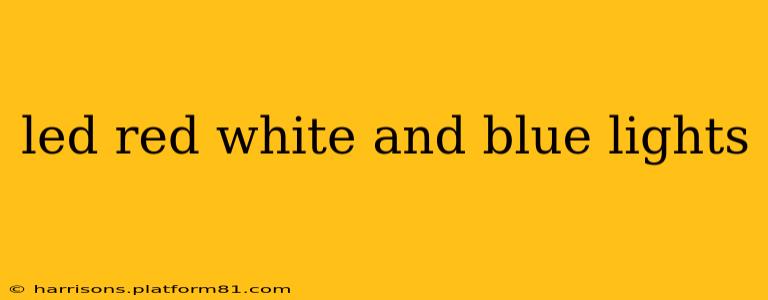LED lights in red, white, and blue are incredibly versatile, finding applications in everything from holiday decorations to automotive lighting and even sophisticated commercial displays. This guide delves into the specifics of these lights, covering their uses, benefits, and considerations for choosing the right ones for your needs.
What are the different types of LED red, white, and blue lights?
Several types of LED lights are available in red, white, and blue, each with its own unique characteristics:
-
Individual LEDs: These are single diodes emitting light in one of the three colors. They are often used in larger arrays or custom-built lighting setups, offering maximum control and flexibility.
-
RGB LED Strips: These strips combine red, green, and blue LEDs that can be individually controlled to produce a wide range of colors, including red, white, and blue. They are popular for accent lighting, mood lighting, and dynamic displays. Mixing red and blue creates purple hues, while combining all three at varying intensities produces white.
-
Pre-assembled Fixtures: You can find ready-made light fixtures, such as spotlights, floodlights, or rope lights, that incorporate red, white, and blue LEDs. These are convenient and often come with pre-set lighting modes.
-
LED Bulbs: Standard light bulbs are available with a red, white, and blue color scheme. These are readily available in various shapes and sizes and are ideal for general lighting applications where color is a key element.
What are the benefits of using LED red, white, and blue lights?
LED red, white, and blue lights offer several advantages compared to traditional lighting options:
-
Energy Efficiency: LEDs are significantly more energy-efficient than incandescent or halogen bulbs, resulting in lower electricity bills and a smaller carbon footprint.
-
Longevity: LEDs boast a much longer lifespan, reducing the frequency of bulb replacements and associated costs.
-
Brightness and Color: They offer vibrant and consistent color output across the red, white, and blue spectrum. The color saturation and brightness are superior to older technologies.
-
Durability: LEDs are resistant to shocks and vibrations, making them suitable for various applications.
-
Versatility: The wide range of available styles and configurations enables their use in diverse settings, from simple illumination to complex lighting designs.
What are the different applications for LED red, white, and blue lights?
The versatility of red, white, and blue LEDs lends them to a plethora of uses:
-
Patriotic Decorations: These lights are extremely popular for decorating homes, businesses, and public spaces during national holidays.
-
Automotive Lighting: They can be used as interior or exterior accent lights for vehicles, providing a customized look.
-
Commercial Displays: Large-scale installations often use these colors in advertising and signage.
-
Stage Lighting: In theaters and event spaces, they are used to create specific moods and effects.
-
Home Lighting: For themed rooms or accent lighting to celebrate special occasions.
How much do LED red, white, and blue lights cost?
The cost of LED red, white, and blue lights varies widely depending on several factors including:
- Type of Light: Individual LEDs are generally cheaper than pre-assembled fixtures.
- Brightness and Wattage: Higher wattage lights will cost more.
- Brand and Quality: Higher-end brands and lights with advanced features tend to be pricier.
- Quantity: Bulk purchases often come with discounts.
You can find inexpensive options for simple lighting applications, while more complex setups or high-quality fixtures will naturally command a higher price.
Where can I buy LED red, white, and blue lights?
You can readily purchase LED red, white, and blue lights from numerous sources:
- Online Retailers: Amazon, eBay, and other online marketplaces offer a wide selection of options.
- Electronics Stores: Local electronics stores often carry a range of LED lights.
- Home Improvement Stores: Home improvement retailers stock a variety of LED lighting solutions.
- Specialty Lighting Stores: For more complex lighting requirements or unique designs, specialized lighting stores may be the best option.
This comprehensive guide provides a solid foundation for understanding LED red, white, and blue lights. Remember to carefully consider your specific needs and budget before making a purchase. By understanding the options available and their features, you can choose the perfect LED lights for your project.
